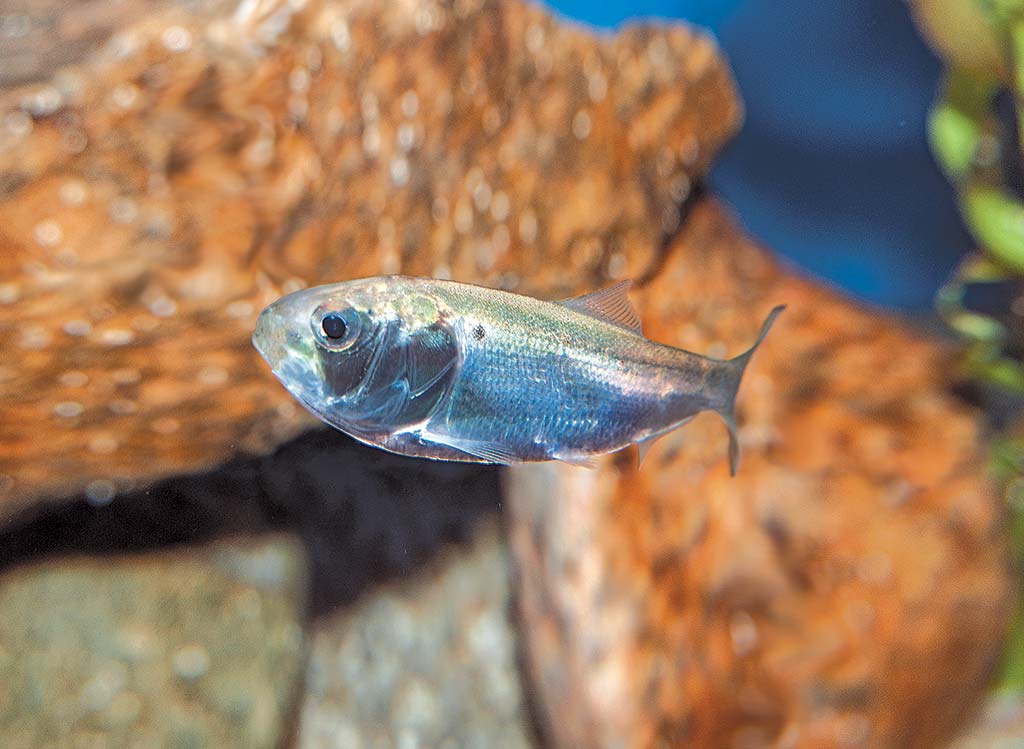Atlantic menhaden, Brevoortia tyrannus, are a cool full bodied ocean-going herring and are usually found in huge numbers during summer months up and down the East Coast.
Menhaden can be found from Nova Scotia south to northern Florida. In the Chesapeake Bay region, this species can be found in waters of all salinity levels. They swim in large schools close to the water’s surface during the spring, summer, and fall. They are also known regionally as pogies, mossbunker, and bunker, by local fishers. When they are well-fed, they are usually referred to as fatbacks or bunkers.
The pogy is very easy to identify verses other ocean-going members of the herring family. The Atlantic menhaden has a deep bodied shape, they always swim with their mouths open, they have a brassy coloration, pale yellow fins, many spots on their sides, and of course, one large spot on their shoulder just behind the gill plate. Menhaden are also strictly an ocean species – they rarely venture far up into rivers like their cousins, the river herring or American shad. This species usually grows to a length of approximately 15 inches and a weight of about a pound as adults. Pogies can live as long as 12 years.

I remember one summer while working on a television project, I came across a massive school of Atlantic menhaden being attacked from below by aggressive bluefish. So, being a young filmmaker at the time, I put on my dry suit, grabbed my video camera system, and jumped into the water to film the encounter. The menhaden stayed right at the surface with their mouths open wide, filter feeding on plankton, while the bluefish kept hitting them from below. The school moved on, and I got out of the water. Then it dawned on me – I had always been told NOT to go in the water with an active school of bluefish, because they may bite through your dry suit during a feeding frenzy. I was glad that did not hit me while in the water – I got the shot of this very interesting encounter, and kept my dry suit in one piece at the same time!
Atlantic menhaden play several important roles in the marine environment. First, they are filter feeders, primarily feeding upon zooplankton, and phytoplankton in the ocean. This species also supports an important commercial fishery – this fish makes-up one of the largest landings, by volume, along the Atlantic Coast of the United States. Pogies are used as fertilizer, feed for animals, and bait for fisheries including the lobster and blue crab industries. They are a major source of omega-3 fatty acids, so they are also used to develop human and animal vitamin supplements. In estuaries like the Chesapeake Bay, they are pursued for food by other larger game fish including striped bass, bluefish and other predator fish species. Menhaden are also caught by ocean-going birds, including eagles and osprey.
Adult menhaden spawn in the coastal waters off the East Coast of the United States. The peak of their spawning season typically runs from December to February, depending upon water temperatures.
The pogy larvae then move into estuarine areas and undergo a physiological change into juveniles. The young menhaden usually stay in the estuarine environments, such as those found in the Chesapeake Bay and Delaware Bay and will stay there and continue to feed and grow for about one year before leaving the estuary to join adult schools of fish.
While this species is usually migratory, moving up and down the coast with the changing seasons, some local schools of fish do not migrate and stay in their home area.
According to the Atlantic States Marine Fisheries Commission (ASMFC), the most recent stock assessment of this species was accepted in February, 2020. The assessment says that Atlantic menhaden are not overfished and that overfishing is not occurring.
The Atlantic menhaden fishery is managed by the ASMFC’s Atlantic Menhaden Management Board. Atlantic menhaden stock assessments and management are currently concentrating their efforts on implementing ecological reference points. These are fishing targets based on the availability of menhaden as prey for other important fish species, including striped bass, weakfish, bluefish, and spiny dogfish, while also taking into consideration for other prey species, including the Atlantic herring.




